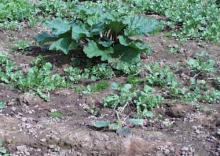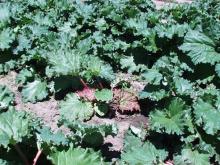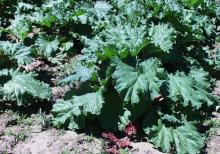Cause The bacterium, Erwinia rhapontici (syn. = Bacterium rhapontici), can cause a crown rot of rhubarb, known as Red leaf or Bacterial soft rot. How the pathogen survives and is dispersed is not well understood. It is suspected that the disease may be spread by plant-feeding insects or by the use of infected root stock.
Symptoms A decay of the crown and terminal buds, brownish rot of pith tissues, and formation of cavities in the crown. A brownish rot begins just below a bud near soil level. Rot gradually extends to tissue above the infection point until it reaches the root's center. The entire plant crown can turn black, and cavities can form within infected crowns. The root's center may become hollow. In wet weather, decay sometimes extends up into the base of the stalk of older leaves. Leaves may be dull red or yellow, and stalks eventually collapse. Spindly side shoots may grow out, but usually they rot off. It may be several months after initial infection before aboveground symptoms are apparent.
Cultural control
- Rogue infected plants; remove and destroy infected plants.
- Avoid replanting into the same area that contained a previously infected plant.
- Management of insect pests in infected fields may be important if Red Leaf is vectored by insects.
- Plant pathogen-free rootstock; avoid propagating from diseased plants.
References Howard, R.J., Garland, J.A., and Seaman, W.L. 1994. Diseases and Pests of Vegetable Crops in Canada. Ottawa: Canadian Phytopathological Society.
Huang, H.C., Phillippe, L.M., and Phillippe, R.C. 1990. Pink seed of pea: a new disease caused by Erwinia rhapontici. Canadian Journal of Plant Pathology 12:445-448.





